

Swarming vs Tiered Support Models Explained. What is Swarming Support?

It’s a reaction to the perceived shortcomings of a ubiquitous ITSM practice: the tiered support model. Perhaps the most well known organisational structure for IT Service Management is the three-tier support hierarchy. Dynamic Systems Development Method (DSDM) The Dynamic Systems Development technique (DSDM) is an associate degree agile code development approach that provides a framework for building and maintaining systems.
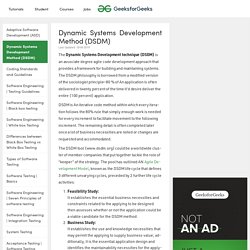
The DSDM philosophy is borrowed from a modified version of the sociologist principle—80 % of An application is often delivered in twenty percent of the time it’d desire deliver the entire (100 percent) application. What is Crystal Method in Agile and How it is different? What Is Agile Project Management? Lean, Agile And Scrum: A Simple Guide [2020] Lean and Agile are two terms that have been rising in recent years among software development teams.
![Lean, Agile And Scrum: A Simple Guide [2020]](http://cdn.pearltrees.com/s/pic/th/agile-scrum-simple-brainhub-233118852)
SAFe Lean-Agile Principles - Scaled Agile Framework. The impression that ‘our problems are different’ is a common disease that afflicts management the world over.
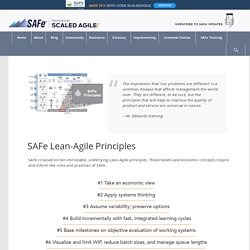
They are different, to be sure, but the principles that will help to improve the quality of product and service are universal in nature. —W. Edwards Deming SAFe is based on ten immutable, underlying Lean-Agile principles. What is Extreme Programming (XP)? Definition Extreme Programming (XP) is an agile software development framework that aims to produce higher quality software, and higher quality of life for the development team.

XP is the most specific of the agile frameworks regarding appropriate engineering practices for software development. When Applicable The general characteristics where XP is appropriate were described by Don Wells on www.extremeprogramming.org: Dynamically changing software requirementsRisks caused by fixed time projects using new technologySmall, co-located extended development teamThe technology you are using allows for automated unit and functional tests Due to XP’s specificity when it comes to it’s full set of software engineering practices, there are several situations where you may not want to fully practice XP.
Extreme Programming Tutorial - Tutorialspoint. Extreme programming (XP) is a software development methodology, which is intended to improve software quality and responsiveness to changing customer requirements.
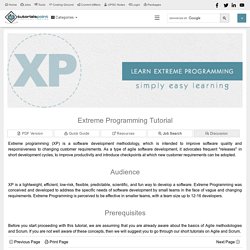
As a type of agile software development, it advocates frequent "releases" in short development cycles, to improve productivity and introduce checkpoints at which new customer requirements can be adopted. XP is a lightweight, efficient, low-risk, flexible, predictable, scientific, and fun way to develop a software. Extreme Programming was conceived and developed to address the specific needs of software development by small teams in the face of vague and changing requirements. Extreme Programming is perceived to be effective in smaller teams, with a team size up to 12-16 developers. Kanban Methodology: What is it and how do you use it? · Airbrake. Kanban (or 看板, literally meaning a sign in Japanese), is used today to signify a form of manufacturing in which all necessary components are managed through the use of a card that indicates missing components.
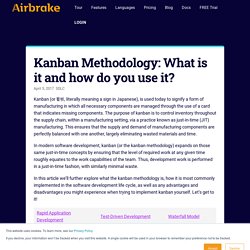
The purpose of kanban is to control inventory throughout the supply chain, within a manufacturing setting, via a practice known as just-in-time (JIT) manufacturing. Kanban - A brief introduction. Kanban for software teams Agile software development teams today are able to leverage these same JIT principles by matching the amount of work in progress (WIP) to the team's capacity.
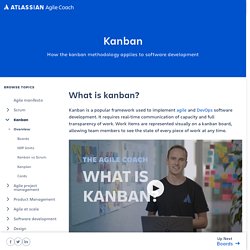
This gives teams more flexible planning options, faster output, clearer focus, and transparency throughout the development cycle. While the core principles of the framework are timeless and applicable to almost any industry, software development teams have found particular success with the agile practice. In part, this is because software teams can begin practicing with little to no overhead once they understand the basic principles. Unlike implementing kanban on a factory floor, which would involve changes to physical processes and the addition of substantial materials, the only physical things a software teams need are a board and cards, and even those can be virtual.
Kanban boards Kanban cards In Japanese, kanban literally translates to "visual signal. " The benefits of Kanban Planning flexibility Pro Tip: Scrum Guides. Resumo. Le registre des activités de traitement. Le registre du sous-traitant doit recenser toutes les catégories d'activités de traitement effectuées pour le compte de vos clients. En pratique, une fiche de registre doit donc être établie pour chacune de ces catégories d’activités (hébergement de données, maintenance informatique, service d’envoi de messages de prospection commerciale, etc.).
Ce registre doit comporter le nom et les coordonnées de votre organisme ainsi que, le cas échéant, de votre représentant, si votre organisme n’est pas établi dans l’Union européenne, et de votre délégué à la protection des données si vous en disposez. Pour chaque catégorie d’activité effectuée pour le compte de clients, il doit contenir les éléments minimaux suivants : /NPPD/PIA-001The EINSTEIN Program. NIST.SP.800 53r5. The SABSA Institute - Enterprise Security Architecture. Frameworks, Standards and Models. Lean Six Sigma Institute. Enterprise Architect. After countless discoveries about the science of Enterprise Architecture from the Zachman Framework 3.0; and due to unprecedented demand, we are proud to offer the Zachman Certified™ - Enterprise Architect program.
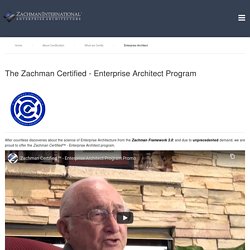
The TOGAF® Standard, Version 9.2. IT Infrastructure Library (ITIL): An Essential Guide. In this guide, learn why an Information Technology Infrastructure Library (ITIL) is essential for your organization and how certification benefits you and your company.

Project Management Certification. Home - DevOps.com. What is Kaizen: The Methodology and Applications. What Exactly Is Kaizen? Taken from the Japanese word for improvement, change for the better, or continuous improvement, the concept of Kaizen has evolved since the 1950s into a business strategy of making small, but continuous changes for the better in company operations. These changes can range from manufacturing steps to productivity, inventory or quality control matters. Kaizen involves every employee and strongly encourages suggestions for improvements, even if they are minor as long as improvements continue. Suggestions coming from all levels of the workplace, from the assembly line to the CEO office, are examined and implemented if useful.
Professional Scrum Master™ I. The Professional Scrum MasterTM level I (PSM I) assessment is available to anyone who wishes to validate his or her depth of knowledge of the Scrum framework and its application. Those who pass the assessment will receive the industry recognized PSM I Certification to demonstrate their fundamental level of Scrum mastery. Taking a course is not required and if you feel that you already possess a high level of Scrum knowledge, understanding of the Scrum Guide and how to apply Scrum within Scrum Teams, you have the option to take the PSM I assessment directly.
Project Management Methodology: Definition, Types, Examples. Without a doubt, a properly defined and strictly followed methodology for managing a project provides a firm guarantee that the job will be done on time, under budget and as per client specification. What is a project management methodology? How can it be defined? In simple terms, it is a must-have to avoid failure and reduce risks because it is one of the critical success factors as well as the core competency of the management team. It is the straightforward way to guide the team through the development and execution of the phases, processes and tasks throughout the project management life-cycle.
Manifesto for Agile Software Development.